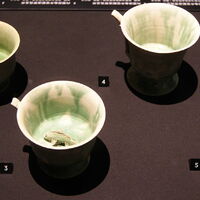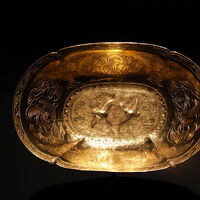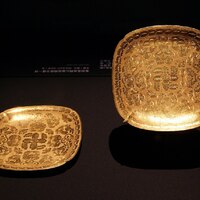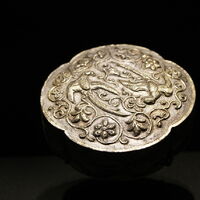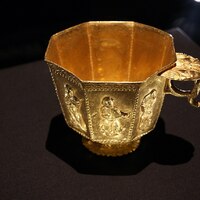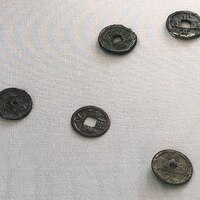Belitung shipwreck
Date:
830s
Location or Findspot (Modern-Day Country):
Indonesia
Medium:
Earthenware,
Gold,
Silver
Description:
The Belitung shipwreck was discovered near and named after Belitung Island in Indonesia. The 60,000 objects salvaged from the wreck reflect the ninth-century Indian Ocean trade (the so-called Maritime Silk Route) between Abbasid Iraq and Tang China. The majority of the items are ceramics, most linked to the Changsha kilns in Hunan Province, but fine metalwork is also represented among the finds. One ceramic object recovered bears a date of 826 CE, which helped to date the wreck. Some recovered objects employ Islamicate aesthetics and even pseudo-Arabic (i.e., illegible) scripts, possibly in a deliberate attempt to make them more desirable in Western Asian markets.
The Changsha bowls, which have an average diameter of 15 cm, are hand painted with flora, fauna, and landscape imagery. Three white stonepaste dishes featuring blue underglaze designs are the earliest intact examples of Chinese "blue and white" wares. These were made using cobalt mined in Iran and may have been made at the Gongxian kilns in Henan Province. A gold octagonal cup has musicians and a dancer with Central Asian features and dress.
The Changsha bowls, which have an average diameter of 15 cm, are hand painted with flora, fauna, and landscape imagery. Three white stonepaste dishes featuring blue underglaze designs are the earliest intact examples of Chinese "blue and white" wares. These were made using cobalt mined in Iran and may have been made at the Gongxian kilns in Henan Province. A gold octagonal cup has musicians and a dancer with Central Asian features and dress.
Relevant Textbook Chapter(s):
5
Repository and Online Resources:
• See more objects from the shipwreck on the website of Singapore's Asian Civilisations Museum.
Image Credits:
Wikimedia Commons


